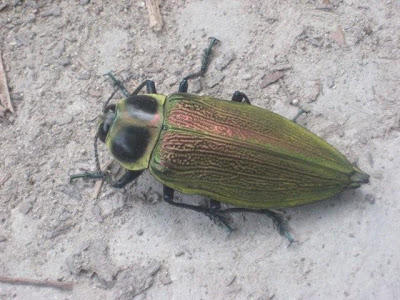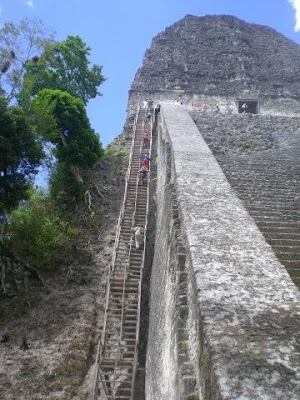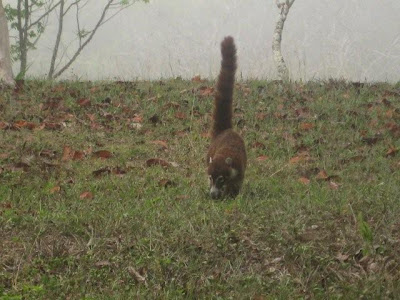The first wonderful part of visiting the ruins of Tikal is that they are situated deep inside the Guatemalan jungle. The towering structures, peering out from above the canopy are incredible - the tallest of which is over 80 metres (not to be climbed by those with vertigo...unless you are as determined/stubborn as my friend Irina!). The Maya settled here around 700 BC; most likely because of the situation on top of a low hill above swamp ground and an abundance of flint for tools and weapons. Within 200 years, the Maya of Tikal had begun to build stone ceremonial structures, and by 200 BC a complex of buildings stood on the site of the North Acropolis.
La Ceiba
This time we spend more time choosing a guide who is knowledgeable and whom we can understand. It is well worth the effort. I learn many snippets of interesting facts about this ancient civilisation from Chino, our guide: The Maya people celebrate with human and animal sacrifice upon altars. They often held ball games, where the losers would be killed. The importance of numbers to the Maya people is evident throughout their structures and sculptures. Zero was an important number, representing the beginning, the end and the cyclical nature of our lives. They were strong believers in astronomy, using both moon and sun calenders. The moon calender represents nine months, the length of a pregnancy cycle; often there are nine stellae and 9 altars on the site. All the sites are connected by underground catacombs, which they may have used for processions and carnivals. Compared with Copan, Tikal shows very little sculptural work.
My favourite story is of Lord Chocolate (Ah Cacau) who was responsible for initiating a Maya renaissance - restoring the city's military strength and its primacy in the Maya world as the most resplendent city. It was he who is responsible for most of surviving temples around the Great Plaza.
Despite Lord Choc's best efforts Tikal's greatness waned in 900AD, part of the mysterious collapse of lowland Maya civilisation. It wasn't until 1848 that it was rediscovered by a Guatemala expedition.


Chultones, these were essentially holes in the ground used for storing maize, beans and other food. There are 9 of these large 'fridges' around the site.

So far, only 20% of Tikal has been excavated and is open to the public, all of which has been funded by international donations.


Chultones, these were essentially holes in the ground used for storing maize, beans and other food. There are 9 of these large 'fridges' around the site.

Chino, our guide showing us one of the Chultones
I was surprised to learn that of Guatemala's 13+ million population today, over 60% are indigenous - nearly all of whom are Maya, with a splattering of European and Caribbean influences in the remainder of the population. The Maya are spread throughout the country, but most densely populated around the Highlands.
So far, only 20% of Tikal has been excavated and is open to the public, all of which has been funded by international donations.
The jungle around Tikal is alive with creatures great and small. During our five-hour walk, we see woodpeckers, macaw, a toucan, pizote, shiny green bugs, red and black howler monkeys and a tarantula. We do not see any pumas, jaguars or rattlesnakes unfortunately.

Our time spent around Tikal, is not quite so majestic. Taca Airlines steal all my toiletries, without prior warning and with a rudeness that taunts my temper. The 38 degree heat, and 60% humidity is unbearable - especially when trying to sleep in 6-bed dorm room and only one measly fan. Irina gets attacked my mosquitos, I get annihilated by bed bugs (to such an extent that I visit the local medic to ask if I have chicken pox). Los Amigos, where the infestation has taken place, has a wonderful communal area and great vegetarian food - so we are upset that we are forced to change to another hostel.
 We do make one worthy discover however; Hibiscus iced tea! Basically one makes hibiscus tea in the usual way, lets it cool & then blends with ice. It is delicious during these extreme temperatures, and the longer-term benefits include cleansing the kidneys and purifying blood.
We do make one worthy discover however; Hibiscus iced tea! Basically one makes hibiscus tea in the usual way, lets it cool & then blends with ice. It is delicious during these extreme temperatures, and the longer-term benefits include cleansing the kidneys and purifying blood.
We feel the liquid flushing out all those toxins injected into to us from all those disgusting bugs....
 We do make one worthy discover however; Hibiscus iced tea! Basically one makes hibiscus tea in the usual way, lets it cool & then blends with ice. It is delicious during these extreme temperatures, and the longer-term benefits include cleansing the kidneys and purifying blood.
We do make one worthy discover however; Hibiscus iced tea! Basically one makes hibiscus tea in the usual way, lets it cool & then blends with ice. It is delicious during these extreme temperatures, and the longer-term benefits include cleansing the kidneys and purifying blood.We feel the liquid flushing out all those toxins injected into to us from all those disgusting bugs....
















Fantastic postings and great pictures of the ruins, any chance to try out ancient Yucatec language skills? :)
ReplyDelete